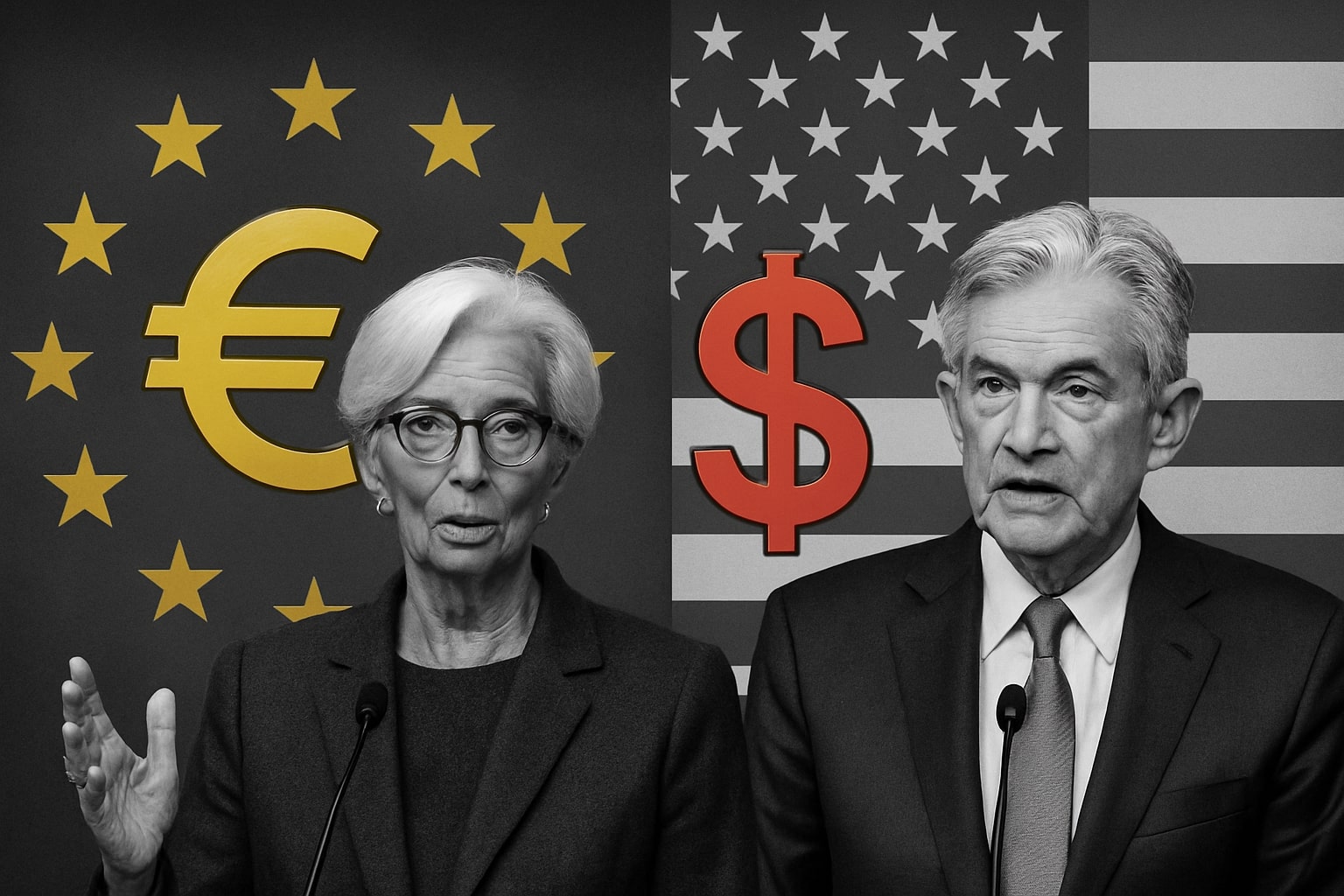
EUR/USD Price Forecast: Euro Holds 1.1514 as Fed Cut Bets Surge and ECB Faces Stagnation
Weak Eurozone PMI, Fed division, and slowing inflation keep EUR/USD under pressure near the 1.1500 pivot as traders brace for key data from both economies | That's TradingNEWS
EUR/USD Price Forecast: Euro Struggles at 1.1500 as Fed Rate-Cut Odds Surge and ECB Faces Weak Growth
EUR/USD trades near 1.1514, hovering just above its critical two-week low of 1.1500, as investors balance diverging fundamentals between the Federal Reserve and the European Central Bank (ECB). The pair fell nearly 0.9% this week, driven by deteriorating Eurozone data, rising U.S. rate-cut speculation, and uncertainty around the December FOMC meeting.
The euro has lost traction after failing to sustain gains above 1.1600, while buyers defend the 1.15 psychological floor — a level that has repeatedly served as a pivot for central-bank and corporate flows since 2017. Momentum remains weak, with RSI near 49 and daily candles forming a tight range between 1.1480–1.1580, showing hesitation before key macro releases.
Macro Drivers: Fed Division and U.S. Data Distortions Pressure the Euro
Recent U.S. data and policy remarks have sharply shifted short-term expectations. New York Fed President John Williams stated last Friday that current policy is only “modestly restrictive,” triggering a market repricing toward faster easing. As of November 22, Fed funds futures price a 71% probability of a 25-basis-point cut in December, up from 39% a day earlier.
However, hawkish comments from Boston Fed’s Susan Collins and Dallas Fed’s Lorie Logan warned against premature easing, leaving the Fed divided and volatility high. The U.S. 10-year Treasury yield, which spiked to 4.51% earlier this month, fell back to 4.42%, reflecting this uncertainty.
The U.S. Dollar Index (DXY 100.08) held steady after rebounding from 98.98, the 61.8% Fibonacci retracement of its 2021-2022 advance. The dollar’s resilience stems partly from risk aversion tied to the Japanese yen (USD/JPY 156.38) and ongoing carry-trade dynamics.
Meanwhile, the government shutdown has delayed key macro data. The missing October employment report and postponed inflation releases have left traders relying heavily on Fed communication and market-implied expectations rather than concrete numbers.
Eurozone Weakness: PMI Contraction and Fragile Manufacturing
The euro’s decline reflects the Eurozone’s weak macro pulse. The composite PMI for November fell to 52.4 from 53.2, marking a renewed contraction in manufacturing. German factory output slipped back into negative territory, reversing mid-month recovery attempts. Industrial production dropped 0.4% MoM, while the services index eased, highlighting uneven post-summer demand.
The IFO Business Climate Index, due Monday, and the Q3 GDP revision on Tuesday will test whether Germany’s stagnation deepens. Consensus expects a flat reading near 0.0% QoQ, confirming the bloc’s narrow escape from a technical recession.
The ECB remains cautious. President Christine Lagarde reiterated that inflation remains above target, but the bank is under pressure as growth stalls and unemployment edges toward 6.5%, its highest since 2021. Market expectations now price an ECB rate cut by March 2026, while the Fed’s earlier pivot risks widening the policy gap.
Technical Landscape: 1.1500 Still the Battlefield
The EUR/USD structure remains technically fragile. The pair’s repeated failure to close below 1.1500 suggests strong institutional demand at this threshold. Historically, similar reactions in 2015–2017 created prolonged range trading between 1.05–1.15.
Resistance lies at 1.1593–1.1656, where the 50-day moving average caps every rebound. A breakout above 1.1660 could open a path to 1.1720, but the prevailing trendline from the September high (1.1978) still defines a dominant bearish channel.
The lower-bound scenario remains more immediate: if EUR/USD closes below 1.1480, sellers could target 1.1400, with further downside toward 1.1320 — a level aligning with 2023’s recovery base. Technical oscillators support caution; MACD is flattening below the signal line, while momentum lags at −0.0008, showing no fresh buying impulse.
Read More
-
SCHD ETF (NYSEARCA:SCHD) Rebounds to $27.10 — Quality Dividend Portfolio Targets 15–18% Annual Return
23.11.2025 · TradingNEWS ArchiveStocks
-
XRP ETFs Launch on NYSE: Franklin Templeton, Grayscale, and Bitwise Drive Institutional Wave
23.11.2025 · TradingNEWS ArchiveCrypto
-
Natural Gas Price Forecast (NG=F) Slips to $4.55 as U.S. LNG Expansion and Asian Imbalance Drive a Global Repricing Wave
23.11.2025 · TradingNEWS ArchiveCommodities
-
Stock Market Today - Wall Street Rebounds as NASDAQ:IXIC Climbs to 22,273; NVDA, AAPL, GOOGL, AMZN, WMT Lead Mixed Session
23.11.2025 · TradingNEWS ArchiveMarkets
-
USD/JPY Price Forecast - Dollar to Yen Nears ¥160 as Fiscal Pressures and U.S. Rate Gap Drive Yen to Breaking Point
23.11.2025 · TradingNEWS ArchiveForex
Correlation and Cross-Market Pressure: The DXY, Equities, and Carry Trades
Correlation with the DXY remains tight at −0.84, meaning further dollar strength could quickly translate into euro weakness. The NASDAQ Composite (NASDAQ:IXIC), which fell 2.1% this week, amplifies this as tech corrections usually drive capital toward the dollar.
The USD/JPY surge beyond 156.00 highlights the ongoing yen carry trade. Despite yen weakness accounting for only 13.6% of DXY weighting, its global liquidity impact is significant. As long as Japanese yields remain elevated and carry positioning stays extended, EUR/USD faces indirect downward pressure from USD inflows tied to hedging strategies.
Event Calendar: Heavy Data Week Ahead
Upcoming U.S. data releases will define short-term direction.
-
Wednesday: October durable goods orders, building permits, and revised GDP.
-
Thursday: Consumer confidence.
-
Friday: Core PCE inflation and PMI updates.
In Europe, the focus is on:
-
IFO survey (Monday), Eurozone retail sales, and German inflation (Thursday–Friday).
Any deviation from forecasts could accelerate momentum near the 1.15 level.
Market Sentiment and Positioning
CFTC data show euro net longs reduced by 18,400 contracts in the latest week, marking the fastest unwind since July. Hedge funds remain cautious, preferring short-term positions within a narrow range. The EUR/USD volatility index (EVZ) climbed to 7.2, its highest since early October, signaling increased speculative positioning ahead of macro data.
Options pricing reveals skew toward euro downside, with 1-month 25-delta risk reversals at −0.45, reflecting stronger demand for dollar calls. Implied volatility for December expiries stands near 8.1%, consistent with traders bracing for policy-driven moves.
Outlook and Market Stance
At 1.1514, EUR/USD trades in a narrow balance of policy uncertainty and technical exhaustion. The pair remains range-bound with downside risk toward 1.1400, though short covering could trigger quick rebounds toward 1.1600 if data surprises.
Given weak Eurozone growth, persistent divergence in rate trajectories, and resilient U.S. macro indicators, the medium-term bias remains bearish. The 1.1500 handle continues to define the battlefield between speculative bears and corporate demand. Unless Fed dovish signals strengthen further or Eurozone data stabilizes above PMI 53, EUR/USD faces continued risk of breakdown toward the mid-1.14 zone.
Final Bias: Sell. The technical and macro landscape support continued dollar strength and downside pressure on the euro until sustained trade above 1.1650 invalidates the bearish structure.



















